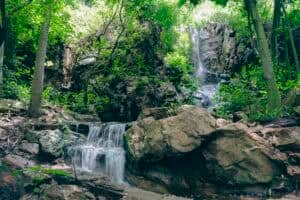The shark net responsible was recently removed and replaced with drumlines.

This net was protecting the often-empty “inside” beach at Richards Bay, KwaZulu-Natal, where many more dolphins were caught than potentially dangerous sharks. The KwaZulu-Natal Sharks Board has replaced the offending shark net with four baited hooks, also known as drumlines, reports Caxton Central.
Humpback dolphins are endangered because they are rare, they reproduce slowly and only occur in a narrow band of very shallow coastal waters, close to shore – an area that is fast being modified and degraded.
In KwaZulu-Natal, the best place to find these shy dolphins is on the Thukela Bank, a shallow shelf that juts out between the Thukela River and St Lucia. Research has revealed Richards Bay is a hotspot for humpback dolphins – an area that is popular with the dolphins but overlaps with many human-induced threats. A major threat is the shark nets.
ALSO READ: Drumlines to replace shark nets along Durban beaches
Shark nets are gillnets set to catch and kill sharks, to lower the population of sharks in order to reduce the risk of shark attacks. In addition to the three species of sharks that are targeted by these nets, other non-target species are caught and killed, including dolphins.
These unfortunate, unintentional catches are called bycatch. In KwaZulu-Natal, there are 37 beaches that have shark nets. One beach, Richards Bay, has by far the greatest bycatch of humpback dolphins (60% of the humpback dolphin bycatch in just 5% of the province’s shark nets).
Since 2010, 26 humpback dolphins have died in the six shark nets at Richards Bay.
Conservation biologists from the project Conserve Dolphins, working in partnership with the KwaZulu-Natal Sharks Board, analysed the spatial distribution of the bycatch and found that nearly half of these deaths occurred in just one of the nets – “net 99”. Over the same period, net 99 caught a single target shark.
The scientists went on to study how often people surf and swim at the Richards Bay beaches. Results indicated that Newark Beach (called “the inside beach” by locals), which is protected by net 99, is used only rarely, on average less than 10 times per month.
At the beginning of April, the KwaZulu-Natal Sharks Board replaced this net with drumlines. Drumlines have been widely used in KZN since 2007 without compromising bather safety, and in Queensland, Australia, since 1962. They work on the same principle as the shark nets; killing sharks to reduce the chance of a shark attack, but on the positive side, they catch fewer non-target species.
Greg Thompson, head of operations at the Sharks Board, said: “Drumlines have proved invaluable in providing protection against shark-inflicted injury along the KwaZulu-Natal coast, catching potentially dangerous sharks, but with very little bycatch of dolphins, rays, turtles, and harmless sharks.”
One net on Alkantstrand’s main beach was also replaced with baited hooks and in total there are now four nets and nine baited hooks protecting bathers at Richards Bay.

The deaths of 26 dolphins in nine years may not sound a lot, but given how rare these dolphins are, and how slowly they breed, that mortality rate is unlikely to be sustainable. Net 99 alone killed an average of 1.2 dolphins per year.
Therefore, removing it could reduce the bycatch by a third and potentially saves one humpback dolphin life each year. That is a significant saving.
“Considering bycatch is one of the main threats to the endangered humpback dolphin in South Africa, this is a huge step forward in the right direction to ensure the species’ long-term survival and well-being in our waters!” observed Dr Els Vermeulen of the SouSA Consortium. The SouSA Consortium is a group of 16 dolphin researchers stationed around South Africa’s coast that have teamed up to study humpback dolphins (Sousa plumbea) at a national level.

Local citizen scientist and dolphin enthusiast Dave Savides is a regular at Richards Bay’s Dolphin Viewing Platform, where he photographs humpback dolphins for the project Conserve Dolphins. In the past, he witnessed one of those 11 dead humpback dolphins being retrieved from net 99. He confesses: “It is such a relief to look out and see these graceful creatures feeding and playing and not have to worry that one might get caught and drown in that awful shark net.”
A webcam looks out over this area, and humpback dolphins can sometimes be seen. This live view of the Richards Bay beaches can be found at www.dolphins.org.za. Viewers are encouraged to report dolphin sightings via the webpage.
* Conserve Dolphins is a project that studies the conservation biology of dolphins and their environment. It is run by marine biologist Shanan Atkins, a member of the SouSA Consortium and a PhD candidate at the University of the Witwatersrand, South Africa. She is assisted by a team of volunteers, from close to home and far afield. The project is supported by the German Society for Conservation of Dolphins, the German Foundation for Ocean Conservation, the Endangered Wildlife Trust’s Kelly Legge Dolphin Fund, Nerospec Networks and the KwaZulu-Natal Sharks Board.
Shanan Atkins can be contacted by calling 082 576 3107, or emailing [email protected].






